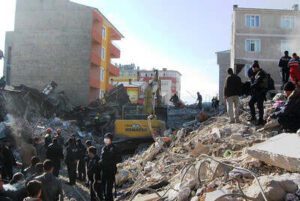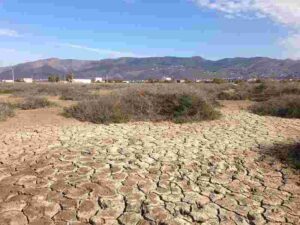9 Examples of Natural Disasters Explained
Examples of natural disasters are; volcanic eruption, earthquake, flooding, mass movement, hurricane, tsunami, heat wave, drought, and wildfire.
This article discusses the examples of natural disasters, as follows;
1). Volcanic Eruption (as one of the Examples of Natural Disasters)
Volcanic eruption is a geologic natural disaster that involves the release of significant amounts of solid, liquid and gaseous materials at high temperature, from the interior of the Earth.
Volcanic eruption is a natural disaster because it is driven mainly by naturally-occurring tectonic forces.
The materials released during volcanic eruption are usually emitted under high-pressure, and include rock fragments, ash, various gases and lava [3].
Due to the high temperature, pressure, and poisonous gases involved, volcanic eruption can be considered to be one of the most potentially dangerous natural disasters that occur on Earth.
Effects of volcanic eruption include loss of arable land resources, natural habitats, lives and property.
A major example of recent volcanic eruption is the Hunga-Tonga-Hunga-Ha’apai eruption that occurred from 20 December 2021 to 15 January, 2022 [10]. The eruption is one of the largest ever recorded, and responsible for at least 6 deaths, alongside many injured, and millions of dollars in economic losses.
2). Earthquake
Earthquake is an example of a natural disaster that results primarily from the dynamics of tectonic forces.
Basically, an earthquake is a series of noticeable tremors or shaking on the Earth’s surface, resulting from the propagation of seismic waves that emanate from the interior of the Earth [9].
These waves are propagated when energy is suddenly released to movement or slippage along a fault line or point of contact, between rocks in the subsurface.
Earthquakes can lead to various outcomes like soil liquefaction, landslides, tsunamis, avalanches, and fire outbreak, all of which could result in major socioeconomic losses.
The magnitude of an Earthquake can be evaluated based on its effects, or the amount of damage caused.
While they are generally not preventable, measures can be taken to predict and mitigate the economic, social and environmental impacts of earthquakes through effective monitoring, and evacuation of vulnerable areas.

3). Flooding (as one of the Examples of Natural Disasters)
Flooding is one of the most common examples of natural disasters.
It is a hydrological hazard, meaning that flooding is induced by, and involves mainly water dynamics.
For flooding to occur, large volumes of water must be present. Such water can come from large bodies of water, or from precipitation.
Usually, flooding occurs after major hydrological events like large-scale snow melting and heavy rainfall [11].
It may be also influenced by other hydrological disasters like tsunamis and cyclones.
Flood waters accumulate when they can no longer be contained effectively by available drainage media in the environment.
For example, the over-filling and overflow of river basins can cause flooding; along with the blockage of manmade water passages by debris and municipal waste.
Also, the failure of water conservation and management structures like dams, also leads to severe flooding.
The potential effects of flooding are significant, and include economic meltdown due to infrastructural damage, destruction of raw materials, and obstruction of transport routes; severe erosion; pollution; injury and death.
4). Mass Movement
Also referred to as ‘mass wasting’, mass movement is a broad term that can be used to describe any natural disaster involving the simultaneous mobilization and downward migration of large masses.
Mass movement is usually a result of slope failure due to weak zones or weight imbalances that create instability, under the influence of gravitational forces [5].
Materials that could be mobilized during mass movement events include rock matter, ice, and soil or debris.
Based on the specific material involved, the mass movement hazard may be described as landslide, avalanche, rockfall, debris flow or mudflow; among others.
The type of disaster caused by mass movement is geological; since it involves mostly earth materials and topographic factors.
Mass movement is most prevalent in mountainous and sloping regions under all climatic conditions, although temperate and tropical climates tend to have higher risk of occurrence due to the gravitational influence of precipitation.
5). Hurricane (as one of the Examples of Natural Disasters)
A hurricane is a natural hazard involving powerful air currents that form as a result of convective dynamics and the Coriolis Effect [6].
Basically, the onset of hurricanes involves the rising of warm, moist air over water, and its replacement by cool air.
Continuous rising and replacement of air masses creates a convective, hydrological and dynamic that results in large clouds and high winds.
Hurricanes can be described as tropical cyclones or typhoons, and are often accompanied by thunderstorms and flooding.
Their impact can be significant, involving major damage and economic losses.
A prominent example of this disaster is Hurricane Katrina; which occurred in the United States in 2005, with more than 1,800 fatalities, 103 deaths, and up to $125 billion worth of damage [2].
6). Tsunami
Tsunamis are large ocean waves that result from tectonic activity and other geologic processes occurring under water; such as earthquake, volcanic eruption, and landslide [8].
These processes displace large volumes of water and send them toward the shore in wave ripples that increase in height as they draw closer to the shore.
Tsunamis travel quite rapidly and can cause significant damage.
7). Heat Wave (as one of the Examples of Natural Disasters)
Heat wave is a meteorological disaster that involves prolonged periods of severely high temperatures [4].
In heat wave events, the rate of air circulation is low, leading to poor air quality conditions that could encourage the persistence of pollutants.
A heat wave could be viewed as the most dangerous or deadly natural disaster, based on its role in causing severe health problems and deaths [1].
However, it is usually given less attention than other hazards like tsunamis and earthquakes, that are more dramatic and impactful in terms of visible infrastructural and environmental damage.
The effects of heat waves include destruction of agricultural crops and natural ecosystems like forests and grasslands; increased risk of wildfires and desertification; and hyperthermia.
8). Drought
Drought refers to a prolonged period of dryness or lower than normal rates of precipitation.
It is caused by human activities that disrupt natural meteorological processes and lead to climate change, or by natural shifts in the trend of geochemical cycles.
Drought is a gradual process of resource depletion (where the resource in question is water) that begins with declining precipitation rates and progresses with evaporation and water consumption.
It is harmful because of the effects of lack of water; which is an essential resource, on the ecosystem.
Soil degradation, increased erosion, food insecurity, hunger, and economic recession, are all effects of drought disaster.

9). Wildfire (as one of the Examples of Natural Disasters)
Wildfire is an uncontrolled fire outbreak that occurs in vegetated areas like grasslands and forests [7].
It is a natural disaster, as there are some naturally-occurring causes of wildfires.
The natural causes of wildfires include lighting and volcanic activity, while other natural hazards like drought and heat waves can increase the risk of occurrence.
However, wildfire may also result from anthropogenic sources like neglected camp fires.
Wildfire incidents could lead to major infrastructural damage if flames extend into human-occupied areas.
These incidents also cause environmental pollution with accompanying health risks; and tend to increase the exposure of soil to degradation.
Conclusion
Examples of natural disasters are;
1. Volcanic Eruption
2. Earthquake
3. Flooding
4. Mass Movement
5. Hurricane
6. Tsunami
7. Heat Wave
8. Drought
9. Wildfire
References
1). Chow, D. (2022). “Heat kills more in U.S. each year than any other extreme weather event.” Available at: https://www.nbcnews.com/health/health-news/heat-waves-deadliest-weather-event-united-states-rcna41129. (Accessed 24 November 2022).
2). Englande, Jr. A. (2008). “Katrina and the Thai Tsunami – Water Quality and Public Health Aspects Mitigation and Research Needs.” International Journal of Environmental Research and Public Health 5(3):384-93. Available at: https://doi.org/10.3390/ijerph5050384. (Accessed 24 November 2022).
3). Hansell, A. L.; Horwell, C. J.; Oppenheimer, C. (2006). “The health hazards of volcanoes and geothermal areas.” Occupational and Environmental Medicine 63(2):149-56, 125. Available at: https://doi.org/10.1136/oem.2005.022459. (Accessed 24 November 2022).
4). Huang, H.; Jie, P.; Yang, Y.; Mi, S. (2022). “Spatial and Temporal Characteristics of High-Temperature Heat Wave Disasters in Chongqing.” Atmosphere 13(9):1396. Available at: https://doi.org/10.3390/atmos13091396. (Accessed 24 November 2022).
5). Kolapo, P.; Oniyide, G.; Said, K. O.; Lawal, A. I.; Onifade, M.; Munemo, P. (2022). “An Overview of Slope Failure in Mining Operations.” Mining 2022, 2(2), 350-384. Available at: https://doi.org/10.3390/mining2020019. (Accessed 24 November 2022).
6). Mendes, D.; Oliveira-Júnior, J. F.; Mendes, M.; Filho, W. L. F. (2021). “Simple Hurricane Model: Asymmetry and Dynamics.” Climate Dynamics 2022. Available at: https://doi.org/10.21203/rs.3.rs-1051026/v1. (Accessed 24 November 2022).
7). Neary, D. G.; Leonard, J. M. (2020). “Effects of Fire on Grassland Soils and Water: A Review.” In (Ed.), Grasses and Grassland Aspects. IntechOpen. Available at: https://doi.org/10.5772/intechopen.90747. (Accessed 24 November 2022).
8). Paris, R.; Switzer, A. D.; Belousova, M.; Belousov, A.; Ontowirjo, B.; Whelley, P. L.; Ulvrova, M. (2013). “Volcanic tsunami: A review of source mechanisms, past events and hazards in Southeast Asia (Indonesia, Philippines, Papua New Guinea).” Natural Hazards 70(1). Available at: https://doi.org/10.1007/s11069-013-0822-8. (Accessed 24 November 2022).
9). Posadas, A.; Morales, J.; Ibañez, J. M.; Posadas-Garzon, A. (2021). “Shaking earth: Non-linear seismic processes and the second law of thermodynamics: A case study from Canterbury (New Zealand) earthquakes.” Chaos Solitons & Fractals 151(2):111243. Available at: https://doi.org/10.1016/j.chaos.2021.111243. (Accessed 24 November 2022).
10). Terry, J. P.; Goff, J.; Winspear, N.; Bongolan, V. P.; Fisher, S. (2022). “Tonga volcanic eruption and tsunami, January 2022: globally the most significant opportunity to observe an explosive and tsunamigenic submarine eruption since AD 1883 Krakatau.” Geoscience Letters 9(1). Available at: https://doi.org/10.1186/s40562-022-00232-z. (Accessed 24 November 2022).
11). Uwamahoro, S.; Liu, T.; Nzabarinda, V.; Habumugisha, J. M.; Habumugisha, T.; Harerimana, B.; Bao, A. (2021). “Modifications to Snow-Melting and Flooding Processes in the Hydrological Model—A Case Study in Issyk-Kul, Kyrgyzstan.” Atmosphere 12(12):1580. Available at: https://doi.org/10.3390/atmos12121580. (Accessed 24 November 2022).




